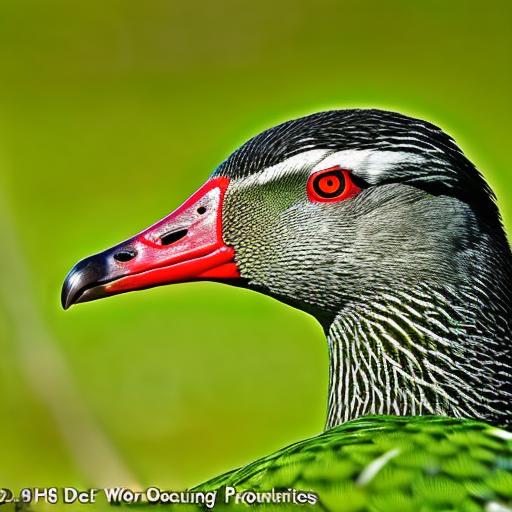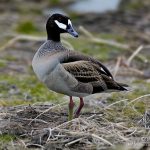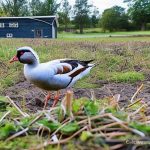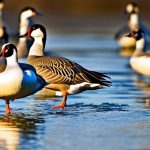Geese are large waterfowl that are commonly found in parks, golf courses, and residential areas. They are known for their distinctive honking sound and their tendency to gather in large flocks. While geese can be a beautiful sight to behold, they can also cause significant damage to lawns.
One of the main ways that geese damage lawns is through their feeding habits. Geese are herbivores and they primarily feed on grass and other vegetation. When a large flock of geese descends upon a lawn, they can quickly strip it of its greenery, leaving behind bare patches of soil. This can be particularly problematic for homeowners who take pride in maintaining a lush and healthy lawn.
In addition to damaging lawns through their feeding habits, geese can also leave behind large amounts of droppings. Goose droppings are not only unsightly, but they can also create a health hazard. The droppings contain high levels of bacteria, which can contaminate the soil and water sources. This can pose a risk to both humans and other animals that come into contact with the droppings.
Key Takeaways
- Geese can cause significant damage to lawns and landscapes.
- Fencing is an effective way to keep geese off lawns and protect them from damage.
- When choosing a fencing material, consider durability, visibility, and cost.
- Accurately measuring and planning for the right amount of fencing is crucial for success.
- Regular maintenance and monitoring of the fence is necessary to ensure its effectiveness.
Understanding the benefits of fencing to keep geese off lawns
One effective method for keeping geese off lawns is the use of fencing. Fencing creates a physical barrier that prevents geese from accessing the area. By installing a fence around your lawn, you can effectively deter geese from causing damage and leaving behind droppings.
Fencing offers several benefits over other methods of goose control. Unlike chemical repellents or noise-making devices, fencing provides a long-term solution that does not require ongoing maintenance or the use of potentially harmful substances. Once a fence is installed, it serves as a permanent deterrent to geese, preventing them from accessing your lawn.
Fencing also allows you to maintain the aesthetic appeal of your lawn. Unlike other methods that may involve unsightly devices or chemicals, a well-designed fence can blend seamlessly with your landscaping and enhance the overall appearance of your property. Additionally, fencing can provide privacy and security, serving multiple purposes beyond just keeping geese away.
Factors to consider when choosing a fencing material
When choosing a fencing material to keep geese off your lawn, there are several factors to consider. Different types of fencing materials offer varying levels of durability, visibility, and effectiveness. It’s important to choose a material that meets your specific needs and preferences.
One common type of fencing material used to deter geese is plastic mesh or netting. Plastic mesh is lightweight, affordable, and easy to install. It creates a physical barrier that prevents geese from accessing the lawn while still allowing for visibility. However, plastic mesh may not be as durable as other materials and may need to be replaced more frequently.
Another option is metal fencing, such as chain link or wrought iron. Metal fencing is highly durable and can withstand the elements. It provides a strong barrier that is difficult for geese to penetrate. However, metal fencing may be more expensive and may not blend as well with the surrounding landscape.
Wooden fencing is another popular choice for keeping geese off lawns. Wood fences can be customized to match the style of your home and landscaping. They provide a solid barrier that effectively deters geese. However, wooden fences may require more maintenance and upkeep compared to other materials.
When choosing a fencing material, it’s important to consider factors such as durability, visibility, cost, and maintenance requirements. You should also check with local regulations or homeowners’ association guidelines to ensure that the chosen material complies with any restrictions or guidelines in your area.
How to measure and plan for the right amount of fencing
Before installing a fence to keep geese off your lawn, it’s important to accurately measure the area that needs to be fenced. This will ensure that you purchase the right amount of materials and plan the layout of the fence effectively.
To measure the area, start by determining the perimeter of your lawn. Use a measuring tape or a long piece of string to measure the length of each side. Add up the measurements to determine the total perimeter.
Next, consider the height of the fence. Geese can fly, so it’s important to choose a fence height that will prevent them from easily hopping over. A fence height of at least 3-4 feet is generally recommended to deter geese.
Once you have determined the perimeter and height, you can calculate the amount of fencing material needed. Most fencing materials are sold in rolls or panels, so you will need to divide the total perimeter by the length of each roll or panel to determine how many you will need.
When planning the layout of the fence, consider any existing structures or obstacles that may affect the installation. Take into account any gates or access points that you may need to include in your design. It’s also important to ensure that the fence is installed at least a few inches into the ground to prevent geese from digging underneath.
Installing and maintaining a fence to keep geese off lawns
Once you have measured and planned for the right amount of fencing, it’s time to install it. While the specific installation process may vary depending on the type of fencing material chosen, there are some general steps that apply to most installations.
Start by marking out the perimeter of your lawn using stakes or spray paint. This will serve as a guide for where to install the fence. Next, dig holes for the fence posts along the marked perimeter. The spacing between posts will depend on the type of fencing material and its recommended installation guidelines.
After digging the holes, insert the fence posts and secure them in place with concrete or gravel. Make sure the posts are level and secure before moving on to the next step. Once the posts are in place, attach the fencing material to the posts according to the manufacturer’s instructions. This may involve using clips, ties, or brackets to secure the material.
After the fence is installed, it’s important to regularly inspect and maintain it to ensure its effectiveness. Check for any signs of damage or wear and tear, such as loose posts or torn mesh. Repair or replace any damaged sections as needed. It’s also a good idea to periodically clean the fence to remove any dirt or debris that may accumulate.
Tips for ensuring the effectiveness of a goose-proof fence
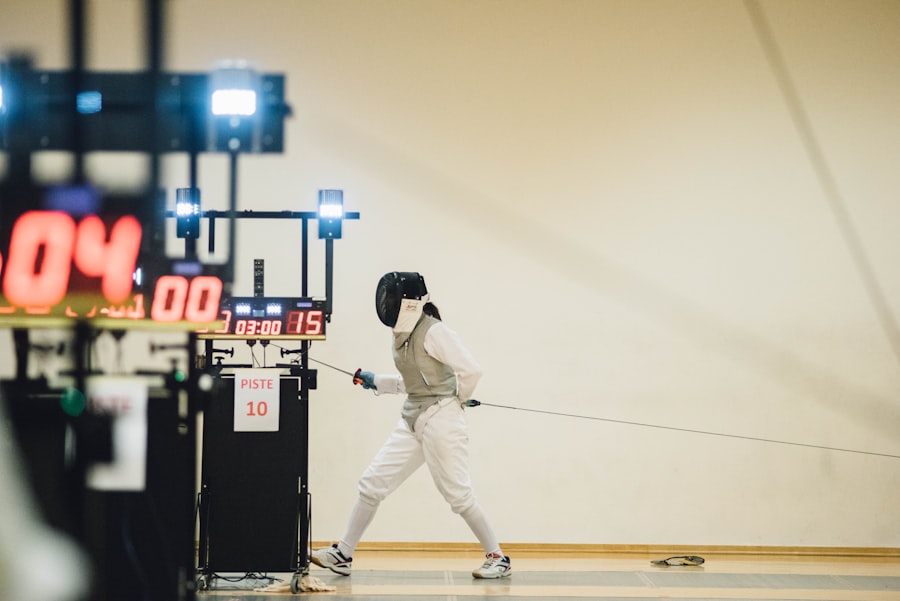
While a well-designed and properly installed fence can be highly effective at keeping geese off lawns, there are some additional measures that can be taken to further deter geese and ensure the effectiveness of the fence.
One option is to install additional deterrents along the fence line. This can include visual deterrents such as scarecrows or reflective tape, as well as auditory deterrents such as wind chimes or motion-activated noise devices. These additional measures can help reinforce the message that your lawn is off-limits to geese.
Another tip is to regularly monitor and address any potential attractants on your property. Geese are attracted to areas with abundant food sources, so it’s important to remove any spilled birdseed, fallen fruit, or other food sources that may be present. By eliminating these attractants, you can reduce the likelihood of geese being drawn to your lawn in the first place.
Additionally, it’s important to regularly inspect and maintain the fence to ensure that there are no gaps or openings that geese could exploit. Check for any signs of wear and tear, such as loose mesh or broken posts, and repair them promptly. Regularly trimming any vegetation near the fence can also help prevent geese from using it as a perch or launching point.
Alternatives to fencing for deterring geese from lawns
While fencing is an effective method for keeping geese off lawns, there are other methods that can be used as alternatives or in conjunction with fencing to further deter geese.
One option is the use of chemical repellents. There are commercially available products that can be sprayed on lawns to make them less appealing to geese. These repellents typically contain natural ingredients that create an unpleasant taste or smell for geese, deterring them from feeding on the grass. However, it’s important to choose a repellent that is safe for both humans and the environment, and to follow the manufacturer’s instructions carefully.
Another alternative is the use of noise-making devices. Geese are sensitive to loud noises and may be deterred by devices that emit sounds that mimic predators or distress calls. These devices can be placed strategically around the lawn to create a deterrent effect. However, it’s important to consider the potential impact on other wildlife or neighbors when using noise-making devices.
Some homeowners have also had success with using visual deterrents such as decoys or scarecrows. These can create the illusion of a predator or other threat, causing geese to avoid the area. However, it’s important to regularly move or change the position of these deterrents to prevent geese from becoming accustomed to them.
The importance of humane and ethical methods for managing geese
When it comes to managing geese and protecting lawns, it’s important to prioritize humane and ethical methods. Geese are living creatures that deserve to be treated with respect and compassion. Using methods that cause harm or distress to geese is not only unethical, but it may also be illegal in some areas.
Humane methods for managing geese focus on deterrence rather than harm. This includes using physical barriers such as fencing, as well as non-lethal deterrents such as noise-making devices or chemical repellents. These methods aim to create an environment that is unappealing or inhospitable to geese, without causing them harm.
It’s also important to consider the potential impact on other wildlife and the environment when implementing goose management strategies. For example, using chemical repellents that are harmful to other animals or pollinators should be avoided. Similarly, noise-making devices should be used judiciously to minimize disturbance to other wildlife or nearby residents.
Addressing potential legal and environmental concerns with goose fencing
While fencing can be an effective method for keeping geese off lawns, it’s important to be aware of and address any potential legal or environmental concerns that may arise.
In some areas, there may be regulations or restrictions on the installation of fences, particularly if they are visible from the street or if they exceed a certain height. It’s important to check with local authorities or homeowners’ associations to ensure that your fence complies with any guidelines or restrictions in your area.
Additionally, it’s important to consider the potential impact on other wildlife and the environment when installing a fence. For example, if your property is located near a wetland or other sensitive habitat, the fence may disrupt the natural movement of wildlife or impede access to important resources. In these cases, it may be necessary to modify the design or location of the fence to minimize its impact.
It’s also important to consider the long-term maintenance and upkeep of the fence. Some fencing materials may require regular painting or staining to maintain their appearance and effectiveness. Additionally, fences may need to be periodically inspected and repaired to ensure that they remain secure and effective at deterring geese.
Conclusion and final thoughts on fencing to keep geese off lawns
In conclusion, geese can cause significant damage to lawns through their feeding habits and droppings. Fencing is an effective method for keeping geese off lawns, providing a physical barrier that prevents them from accessing the area. Fencing offers several benefits over other methods, including long-term effectiveness and minimal maintenance requirements.
When choosing a fencing material, it’s important to consider factors such as durability, visibility, cost, and maintenance requirements. Plastic mesh, metal fencing, and wooden fencing are all popular options that offer different advantages and disadvantages. It’s important to choose a material that meets your specific needs and preferences.
Before installing a fence, it’s important to accurately measure the area that needs to be fenced and plan the layout accordingly. Once the fence is installed, regular maintenance and inspection are necessary to ensure its effectiveness. Additional measures such as installing deterrents or addressing potential attractants can further enhance the effectiveness of the fence.
While fencing is an effective method for keeping geese off lawns, there are other alternatives that can be used in conjunction with or as alternatives to fencing. Chemical repellents, noise-making devices, and visual deterrents can all be effective at deterring geese. However, it’s important to prioritize humane and ethical methods that do not cause harm or distress to geese.
Finally, it’s important to address any potential legal or environmental concerns that may arise with goose fencing. Checking with local authorities or homeowners’ associations and considering the potential impact on other wildlife and the environment can help ensure that your fence is compliant and environmentally responsible.
Overall, by using fencing and other humane methods, homeowners can effectively manage geese and protect their lawns from damage.
If you’re looking for effective ways to keep geese off your lawn, fencing is a popular solution. However, it’s important to choose the right type of fencing to ensure its effectiveness. In a related article on Poultry Wizard, you can find valuable insights on creating a secure and goose-proof enclosure for your property. From farmhouse chicken coops to the best types of coop designs, this article offers practical tips and ideas to help you keep your lawn free from unwanted feathered visitors. Check out the article here for more information.
Meet Walter, the feathered-friend fanatic of Florida! Nestled in the sunshine state, Walter struts through life with his feathered companions, clucking his way to happiness. With a coop that’s fancier than a five-star hotel, he’s the Don Juan of the chicken world. When he’s not teaching his hens to do the cha-cha, you’ll find him in a heated debate with his prized rooster, Sir Clucks-a-Lot. Walter’s poultry passion is no yolk; he’s the sunny-side-up guy you never knew you needed in your flock of friends!

